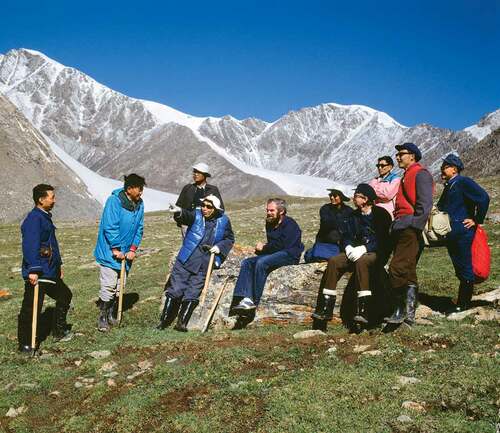Roger G. Barry was born in Yorkshire, England, in 1935. While studying for university entrance he worked as an assistant in the U.K. Meteorological Office. He then studied geography at Liverpool University, obtaining a first class honors degree in 1957.
I first met Roger after he was attracted to Canada by Professor F. Kenneth Hare. I was delighted that Hare had seized on Roger’s enthusiasm for climatology and appointed him as climate observer at the McGill Sub-Arctic Research Lab in central Labrador-Ungava. He arrived at the Lab a few days before I took up my post as Lab field director. There began a lifelong friendship such that I find it painful to write this obituary.
In contrast to the many obituaries for Roger that I have already received, here I will emphasize some of his more personal characteristics. That first winter in the sub-arctic revealed many aspects of Roger’s caring and quiet personality. For instance, he helped the Rev. Gavin White to hack through the frozen ground to bury that winter’s Naskaupi Indian victims of an influenza epidemic, returning to the Lab almost frozen at the end of a long day. He practiced his violin assiduously until some mischievous co-observer pasted a notice on his office-cum-bedroom door to read: ‘Mr. Barry’s Music Room’. To help out, when away for the evening, we invited him to use our living room for practice: returning home early one evening, we surprised him desperately following Alfredo Campoli on a recording of Mendelssohn’s violin concerto – only two bars behind!
We enjoyed discussing what climatic conditions would induce initiation of the Laurentide Ice Sheet, a topic that subsequently became the essence of his McGill geography Master’s degree. He spent that first winter as a meticulous weather observer and, on the side, outstripped the main Dept. of Transport, Dorval forecast office, with the Iron Ore Company of Canada preferring his weather forecast, for instance, when the next day’s temperature would be safe, or not safe, to begin a major concrete-pouring operation.
After completing his Master’s degree the following year at McGill, he returned to England to take up an assistant lectureship in the Geography Department, University of Southampton. There he also completed his doctorate with Ken Hare serving as external examiner. In 1966–67 he took his sabbatical leave with the Geographical Branch, Canada Dept. of Energy, Mines and Resources. That led him to Baffin Island and laid the foundation for him to join me at INSTAAR in 1968 with an Associate Professorship in the Geography Department. There began a very close friendship. His contributions were outstanding and often quietly voluntary with no prospect of personal reward: analysis of 15 years of Front Range climate data; long hours assisting Kathleen Salzberg and me with the launch of the new quarterly journal, Arctic and Alpine Research; co-editorship of the 1,000 page Methuen book, Arctic and Alpine Environments (1974). Later he played a pivotal role in the founding of the International Mountain Society and in the production of its journal: Mountain Research and Development. And when Dr. Alan Shapley arranged for the transfer from the National Oceanographic and Atmospheric Administration (NOAA) of the World Data Center for Glaciology (WDCG) to CU in 1976, he took over as its director. Shortly thereafter he transferred with WDCG to the Cooperative Institute for Research in Environmental Sciences (CIRES) where the National Snow and Ice Data Center was added in 1982. From thereon Roger proceeded to build up a large staff and achieve for the combined units an international reputation.
From this point Roger’s career spanned the world: a heavy involvement with the Soviet Union; sabbatical leaves in Australia, Papua New Guinea, New Zealand, Germany, USSR, Switzerland and China (). There were many international acclamations:
John Simon Guggenheim Memorial Fellowship
The Humboldt Prize, Bavarian Academy of Sciences
Goldthwait Polar Medal (Byrd Polar Research Center)
Founder’s Medal of the Royal Geographical Society
Distinguished Professor of Geography, CU
Review Editor for IPCC Working Groups 1 and 2 in 2007
He was an invited guest professor in many countries, with the ability to lecture in German, French, and Russian, and English. He supervised more than 60 graduate students, 36 earning their doctoral degrees. Many of them became internationally renowned scientists.
Figure 1. 1981 in the Tien Shan (Mountains of Heaven) when China was still closed to foreign visitors. Our group walked to Glacier Number 1 (background–right). Roger is wearing white gloves and Gordon Young is seated next to him. Professor Shi Yafeng, China’s founder of glaciology, pointing to a distance feature, later visited us in Boulder, Colorado. Photo: Jack Ives

Perhaps the most impressive long-term contribution is Roger’s publication record: over 30 text books, including editions in several languages, and several hundred reviewed papers, scientific reports and editorial contributions. At the time of his death I was reading through the proofs of his latest book Polar Environments co-authored with Eileen Hall-McKim, to be published by Cambridge University Press.
I conclude by affirming that Roger is the most impressive scientist I have had the privilege of knowing: a loyal friend and colleague, always with time to spare; a great lover of opera and classical music; one who has contributed immeasurably to mountain and polar environments and the conviction that climate warming must be tackled more vigorously worldwide.
